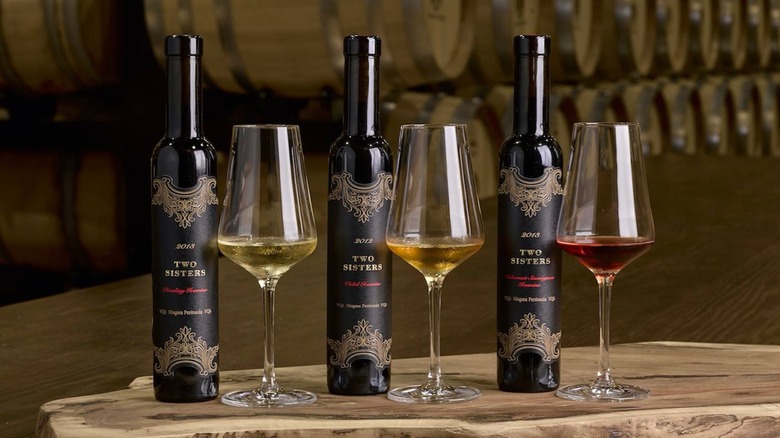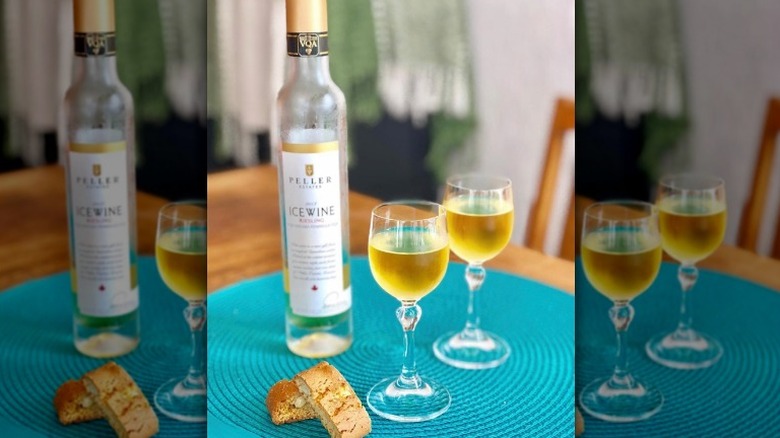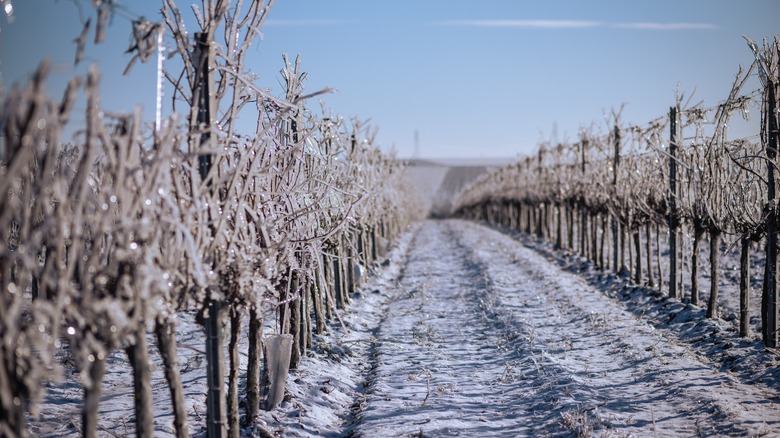Everything You Need To Know About Icewine
For the not yet initiated, Canadian wine is often synonymous with icewine. Given the fact that only approximately .02% of wine exports worldwide by volume come from our northerly neighbors, (per Wine Growers of Canada), it makes sense that international consumers don't always see the full picture. Still, there's a reason why icewine and Canada go hand in hand. The country arguably put the sweet beverage on the map, and it produces the stuff year after year thanks to frigid temperatures.
If you've never tasted the elixir, you may be hesitant to spontaneously pick up a bottle at the wine shop considering the heftier price tag. However, icewine isn't the type of drink you sip on throughout the night, polishing off a bottle with a friend. The high sugar content regulates consumption, making it a pleasant treat to have as an aperitif or digestif. There is no shortage of reasons why you should try icewine, and just as many qualities that make it a must-have addition to your wine rack. Discover everything you need to know about this sweet winter harvest treat.
Specific climatic conditions are required
If you haven't walked through a vineyard in the winter, it can be hard to imagine the lay of the land. Considering that many wine regions in Canada experience a winter wonderland atmosphere in the cooler months, snow is commonly part of the picture. However, a snowy vine isn't part of the exacting standards of icewine production.
Regulatory bodies determine the specifications, with the Vintners Quality Alliance (VQA) in charge in British Columbia and Ontario, and production in Quebec defined by a Protected Geographical Indication (PGI). Minor variations distinguish the guidelines between provinces, but the general idea is the same. For starters, icewine is a late-harvest product, which means the grapes hang on the vine longer than usual, further ripening. This causes the sugar content to continue rising to meet the minimum required for icewine.
The ambient temperature and that of the grapes must be equal to or below -17.6 degrees Fahrenheit, which typically pushes harvest to anytime between late November and February. Furthermore, to ensure the grapes remain frozen by the time they reach the cellar, vintners tend to seek a period when temperatures are below the threshold for multiple consecutive days.
The harvest and production are laborious
Given the precarious nature of timing harvest with temperature fluctuations, vintners have to plan accordingly. To ensure temperatures remain subfreezing, grapes are often picked during the night. The process can take several hours, as the fruit is commonly hand-harvested by brave souls. Since the operation is highly weather-dependent, wineries gather as many people as possible to help with the task.
Harvesting grapes that are frozen on the vine and remain frozen as they are pressed is a critical feature of icewine. Therefore, the job isn't over once the grapes are picked; they must be transported to the winery and quickly pressed to obtain the juice. Depending on the size of the harvest, this can take anywhere from several hours to a full day. To ensure absolute iciness, cellar doors are usually left open to avoid any premature melting.
Considering the frosty nature of the fruit, a greater amount of pressure is needed to press the juice out of the grapes. There is a more than 10-fold increase in the pressure between standard and frozen grapes; regular winery equipment certainly won't cut it. Once the juice is collected, there are still several obstacles. The characteristic high sugar content can impede the fermentation process by overloading the yeast with sugar to convert to alcohol. Finding the right balance of sugar, flavor, acidity, and the alcohol content is a tricky endeavor that demands expertise.
Only small amounts can be produced
If you stop to consider the amount of juice that you could squeeze out of a fresh grape versus a frozen one, it's clear that yields are drastically reduced. The sugar becomes highly concentrated in the juice, while the water content freezes. Effectively, the winemaker is left with a mere fraction to work with, around 15% of regular harvest yields (via Wines of Canada). Given the minimal amount of juice, far more grapes are required to produce icewine. Wine Country Ontario estimates one 375-milliliter bottle calls for about 7 to 8 pounds of grapes, which would be sufficient to make around three 750-milliliter bottles of table wine.
Furthermore, the grapes have to remain on the vine for longer than usual, making them vulnerable to a range of factors. Heavy windstorms, hail, rain, mold, disease, birds, and assorted animals are just some of the risks vintners face. If the fruit ends up hanging for extended durations, it can become overly dehydrated, reducing the already limited juice content. Not to mention, the weather can be finicky and unpredictable throughout the winter, ultimately banishing the hope of any production at all.
Icewine retails at a high price
Considering the factors that go into growing grapes, ensuring they are still healthy and hanging on the vine late into the season, and finally harvesting them and producing icewine, it isn't surprising that bottles sell at a higher price than the average table wine. The process is a risk both financially and time-wise for wineries, which is worth keeping in mind if you find yourself balking at the cost of a 375-milliliter bottle.
If grapes are set aside for icewine only to be decimated following a storm or a swarm of hungry birds, it's tough luck for the vintners. As well, yields are a tiny proportion of regular wine production, regardless of the fact that greater labor efforts are required for harvest, processing, and fermentation. Ultimately, it comes down to scarcity; less fruit means less juice and, consequently, less wine.
That being said, treating icewine like a special gift from winter is part of the enjoyment for avid oenophiles. There are variations in price depending on the winery, grape variety, year, and more, but expect to pay between $50 and $150 for a 375-milliliter bottle. Then again, that's not so bad if you consider that Royal DeMaria winery in Ontario offers a bottle of its 2000 Chardonnay winter harvest wine for $250,000.
It dates back to the Ancient Romans
Although icewine production's recent history can be attributed to Germany and its rise in popularity partly a result of Canada's extensive exports, its origins are far older. According to Wines of Germany, evidence indicates that back in 44 AD, writer and philosopher Pliny the Elder wrote about the process of making wine with frozen grapes.
Amidst it all are reports of grapes freezing on the vine and an ensuing sweet wine. The region of production mentioned is home to a few modern-day Italian icewines, further backing up the theory. That being said, Italy commonly produces wines made from dried grapes, and the frosty nature of the fruit he mentions may have been an exception.
Many centuries later in the late 1700s/early 1800s, a premature bout of frost hit Germany's Rheingau region, threatening to destroy a season of growth. Instead of abandoning all hope, winemakers pressed the grapes and discovered the sweet nectar. Official written reports of modern production date to 1830, when grapes picked in February resulted in a delicious sweet wine (via Wines of Germany).
Typically only a handful of grape varieties are used
Since grapes used for icewine hang on the vine accumulating sugar and intensifying flavors, an element of acidity is definitely welcome. The best way to balance sweetness is with acidity, and when the two are in equilibrium, the wine won't be perceived as outrageously sweet. For this reason, high acidity and aromatic notes are common features of icewine varieties. Not to mention, they have to be capable of resisting the frosty temperatures typical of regions where the wine is produced.
Icewine-producing areas tend to restrict the grapes permitted. Riesling, chardonnay, and gewürztraminer are common Vitis vinifera varieties. In Germany, the modern birthplace of icewine, riesling reigns as king. For something different, red grapes cabernet franc and occasionally cabernet sauvignon are also used to make icewine.
Meanwhile, a hybrid grape called vidal blanc is highly prized in icewine production thanks to its dependable results in the vineyard and cellar. The grape's thicker skins, resistance to cold temperatures and common vineyard pests, and high acid aromatic profile make it an excellent option for icewine.
Not all icewine is authentic
As is often the case with rare and expensive items, phony icewine is not an uncommon occurrence. Given the fastidious regulations surrounding the subzero temperatures, the sugar content of the grapes, and various steps throughout the production process, it's no surprise that some winemakers welcome a shortcut. The Government of Canada outlines its standards of identity for labeling products as icewine, with fines reaching $100,000 for mislabeling, as reported by The Globe and Mail. A telltale sign that your icewine isn't the real deal is if it's labeled as iced wine, though some producers do a commendable job of mimicking the authentic stuff.
In regions where temperatures are not consistently cool enough, grapes are harvested as per usual and then frozen in freezers in a process known as cryoextraction. Though it guarantees frozen grapes regardless of winter conditions, the fruit does not accumulate sugar and concentrated flavors as it does from hanging on the vine for a long duration.
Using cryoextraction offers the winery more leeway with the production schedule and costs and guarantees higher yields since the fruit isn't increasingly vulnerable throughout the winter. Meanwhile, other winemakers interviewed by the outlet concurred that iced wine has less depth of flavor, considering it isn't a late-harvest wine. Nevertheless, when properly identified, both products are appreciated by a range of consumers looking for sweet wines, and the manufactured version provides an affordable compromise.
Canada is the leading country by volume
Even though Canada is not the birthplace of icewine, it is the country most commonly associated with the beverage partly because it produces so much of the stuff. According to Export Development Canada, icewine draws in CDN $23 million a year (around $17 million), placing Canada firmly at the top of production worldwide. China is by far the top importer of Canadian icewine, followed by the United States, notes Statista.
To their benefit, our northern neighbors experience consistently cool winters to guarantee suitable conditions for icewine harvest. The majority of the close to 100 wineries that produce icewine are located in the province of Ontario (primarily in the Niagara Peninsula), followed by British Columbia, Quebec, and Nova Scotia (via Natalie MacLean). These regions span the length of the vast country, covering areas from the west to the east coast. Not to mention, the country has a well-established legacy of making the sweet elixir, as evidenced by a regular slew of international awards.
The flavor is unlike any other type of wine
Considering the number of hurdles winemakers jump through in order to produce icewine and the price consumers pay for it, it's worth diving into its flavor profile. As a result of the late harvest date, grapes continue to ripen on the vine well into the winter, concentrating the aromas and increasing the sugar content of the fruit and overall intensity. The beverage tends to be medium to full-bodied with a relatively low alcohol content of around 10% as Natalie MacLean outlines.
Since the wine can be made with several different grape varieties, each offers its own characteristics of aromas. Common flavors include honey, tropical fruits, stone fruits, and citrus. Meanwhile, red icewine displays more notes of red berries. Icewine is unapologetically rich with a luscious character, but its notable sweetness is contrasted by a high acidity, resulting in a pleasantly balanced drink. Additionally, some icewine is matured in oak barrels, adding to the complexity of flavors.
It is distinct from other dessert wines
Sweet wines are the result of different processes, including fortification, halted fermentation, late harvest, and noble rot, making each one distinct. Natalie MacLean shared with us that, "Most people think of icewine as syrupy sweet and high in alcohol, like other dessert wines." She highlights, "icewine's sweetness is less intense than Port," and it contains "about half the alcohol at just 10 to 11% compared to port at 19 to 20%." Port is a fortified wine, which ups its alcohol content, whereas wines that go through a shortened fermentation process are typically sweet and low in alcohol (like moscato).
Meanwhile, late-harvest wines are made from grapes that hang on the vines for extended periods of time, accumulating flavor and sugar content. Unlike icewine, the duration is not dependent on frost, so winemakers have more control over when to pick the grapes. Furthermore, the taste is not quite as concentrated since although the fruit dehydrates, the water does not freeze and separate from the juice as with icewine.
Noble rot occurs as grapes sit on the vine over time, and as per the name, is the result of a unique type of mold called botrytis cinerea. As it finds its way into the grapes, the fruit dehydrates, intensifying sugars and flavors and producing a rich and honeyed flavor with notes of dried fruits (via Natalie MacLean). Famous examples of this product are Sauternes from Bordeaux, France, and Tokaji Aszú from Hungary.
It offers a range of unique food pairings
Although icewine is a dessert wine, there are plenty of ways to savor it. Thanks to the balance of sweetness and high acidity, the pairing options are versatile. While it is undoubtedly a richly flavored wine, these characteristics offer levity that prevents it from being overly unctuous.
"Most people don't think of drinking it at the beginning of the meal," Natalie MacLean comments. She adds, "It's a lovely complement to foie gras instead of the traditional Sauternes, or try it with cheese and charcuterie." It cuts through creamy textures and matches well with jellies or chutneys too.
With flavors of tropical fruit and citrus, icewine makes a novel match for white meat dishes. Consider it the next time you prepare pork or poultry with stewed fruits. As well, creamy seafood-based recipes can benefit from a vibrant splash of acidity and fruit-forward flavors. On the other hand, delicate preparations such as sashimi are equally enhanced by the sweet elixir. Thanks to the high residual sugar content, icewine counters the heat of spicy foods. Pair it with a zesty Thai stir-fry or with a rich curry to cleanse your palate.
Naturally, dessert is a great excuse to pull out a chilled bottle. A glass offers a sweet finish without weighing you down, or as MacLean notes, "Icewine pairs beautifully with fruit flans and cobblers." Meanwhile, if you've snagged a bottle of red, try it with a chocolate dessert for the ultimate decadence.
Climate change might alter icewine's future
With Canada being the only country sufficiently cold to consistently produce icewine year after year, it's clear that the future of this delectable drink is on shaky grounds. Not only do temperatures have to drop in order for grapes to freeze, but they have to remain low for sufficient time at a reasonable stage of the winter to avoid losing too much fruit.
Jamie Slingerland oversees viticulture at Niagara-on-the-Lake's Pillitteri Estates Winery in Ontario and is no stranger to the changing timeline of harvest. The unpredictable weather places a lot of pressure as far as selecting when to harvest. Based on data from Ontario's Cool Climate Enology and Viticulture Institute, the number of days below the threshold temperature has decreased in the past decades, limiting the appropriate conditions for icewine production. Slingerland notes that his team has had to transition to mechanical harvesting given the impossibility of accomplishing a harvest by hand in the short timespan allotted in certain years.
Countries in Europe are regularly skipping out on icewine production due to rising temperatures. As researcher Gary Pickering in Ontario notes, Canada is well-situated to face these upcoming challenges as it has a large mass of land north of its wine-growing regions. Additionally, growers are experimenting with grape varieties that may fare better with the changing temperatures.












